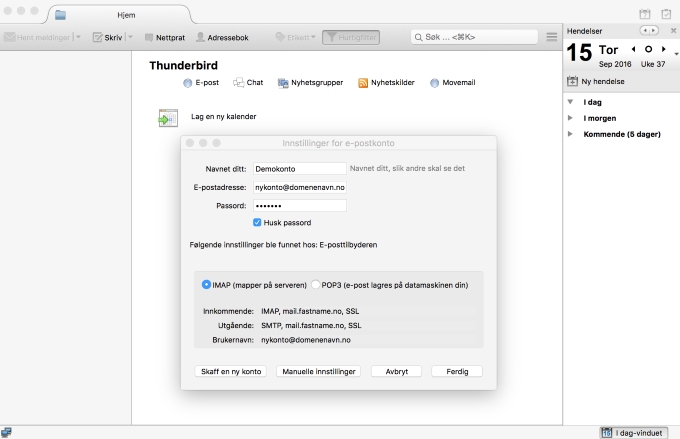Db: 3.66:ot: Thunderbird For Mac
IndexedDB is a low-level API for client-side storage of significant amounts of structured data, including files/blobs. This API uses indexes to enable high-performance searches of this data. While is useful for storing smaller amounts of data, it is less useful for storing larger amounts of structured data.
IndexedDB provides a solution. This is the main landing page for MDN's IndexedDB coverage — here we provide links to the full API reference and usage guides, browser support details, and some explanation of key concepts. Note: IndexedDB API is powerful, but may seem too complicated for simple cases. If you'd prefer a simple API, try libraries such as, and that make IndexedDB more programmer-friendly. Key concepts and usage IndexedDB is a transactional database system, like an SQL-based RDBMS. However, unlike SQL-based RDBMSes, which use fixed-column tables, IndexedDB is a JavaScript-based object-oriented database. IndexedDB lets you store and retrieve objects that are indexed with a key; any objects supported by the can be stored.
You need to specify the database schema, open a connection to your database, and then retrieve and update data within a series of transactions. Read more about the. Learn to use IndexedDB asynchronously from first principles with our guide.
Find developer recommendations for making web apps work offline at our page. Note: Like most web storage solutions, IndexedDB follows a. So while you can access stored data within a domain, you cannot access data across different domains. Synchronous and asynchronous Operations performed using IndexedDB are done asynchronously, so as not to block applications. IndexedDB originally included both synchronous and asynchronous APIs.
The synchronous API was intended for use only with but was removed from the spec because it was unclear whether it was needed. However, the synchronous API may be reintroduced if there is enough demand from web developers.
Storage limits and eviction criteria There are a number of web technologies that store data of one kind or another on the client side (i.e. On your local disk). IndexedDB is the most commonly talked about one. The process by which the browser works out how much space to allocate to web data storage and what to delete when that limit is reached is not simple, and differs between browsers. Attempts to explain how this works, at least in the case of Firefox. Interfaces To get access to a database, call on the attribute of a object. This method returns an object; asynchronous operations communicate to the calling application by firing events on objects.
Connecting to a database Provides access to IndexedDB functionality. It is implemented by the and objects. This interface isn't part of the 2.0 specification. Provides access to a database.
Is this ad super-inappropriate? Or are you cool with seeing it the next time you go to the mall? Miley cyrus spreads her legs for mac. What do you think?
This is the interface implemented by the global object and is therefore the entry point for the API. Represents a request to open a database. Represents a connection to a database. It's the only way to get a transaction on the database. Retrieving and modifying data Represents a transaction.
You create a transaction on a database, specify the scope (such as which object stores you want to access), and determine the kind of access (read only or readwrite) that you want. Generic interface that handles database requests and provides access to results. Represents an object store that allows access to a set of data in an IndexedDB database, looked up via primary key. Also allows access to a subset of data in an IndexedDB database, but uses an index to retrieve the record(s) rather than the primary key.
This is sometimes faster than using. Iterates over object stores and indexes. Iterates over object stores and indexes and returns the cursor's current value. Defines a key range that can be used to retrieve data from a database in a certain range. Defines a key range that can be used to retrieve data from a database in a certain range, sorted according to the rules of the locale specified for a certain index (see.). This interface isn't part of the 2.0 specification. Custom event interfaces This specification fires events with the following custom interface: The IDBVersionChangeEvent interface indicates that the version of the database has changed, as the result of an event handler function. Obsolete interfaces An early version of the specification also defined these now removed interfaces.
Db: 3.66:ot: Thunderbird For Mac Mac
They are still documented in case you need to update previously written code: Represents a request to change the version of a database. The way to change the version of the database has since changed (by calling without also calling ), and the interface now has the functionality of the removed. Represents exception conditions that can be encountered while performing database operations. Sync version of. Sync version of.
Sync version of. Sync version of. Sync version of. Sync version of.

Sync version of. Examples.
A powerful library and eBook reader application, written by Marco Castelluccio, winner of the IndexedDB Mozilla DevDerby. : The reference application for the examples in the reference docs. Specifications Specification Status Comment Recommendation Initial definition Recommendation Browser compatibility. Feature Chrome Edge Firefox (Gecko) Internet Explorer Opera Safari (WebKit) Basic support 23 24 (unprefixed) 38 (prefixes deprecated) 57 (prefixes removed) (Yes) (10.0) (16.0) 10 15 7.1, partial 10 Available in workers (Yes) (unprefixed) 38 (prefixes deprecated) 57 (prefixes removed) (Yes) (37.0) 1 (Yes) (Yes) 10 Available in privacy mode 3 (Yes) No support No support No support No support No support IDBLocaleAwareKeyRange No support No support (43.0) 2 No support No support No support Indexed Database 2.0 58???